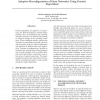883 search results - page 49 / 177 » A Genetic Algorithm Applied to the Maximum Flow Problem |
ICPR
2008
IEEE
14 years 8 months ago
2008
IEEE
Learning typical motion patterns or activities from videos of crowded scenes is an important visual surveillance problem. To detect typical motion patterns in crowded scenarios, w...
CEC
2005
IEEE
14 years 1 months ago
2005
IEEE
A grouping genetic algorithm (GGA) for the university course timetabling problem is outlined. We propose six different fitness functions, all sharing the same common goal, and look...
ASC
2004
13 years 7 months ago
2004
Genetic algorithms are applied to an important, but little-investigated, network design problem, that of reconfiguring the topology and link capacities of an operational network t...
TSP
2010
13 years 2 months ago
2010
Abstract--This paper deals with the reconstruction of T1-T2 correlation spectra in nuclear magnetic resonance relaxometry. The ill-posed character and the large size of this invers...
GECCO
2003
Springer
14 years 25 days ago
2003
Springer
Abstract. A brachistochrone is the path along which a weighted particle falls most quickly from one point to another, and a catenary is the smooth curve connecting two points whose...

